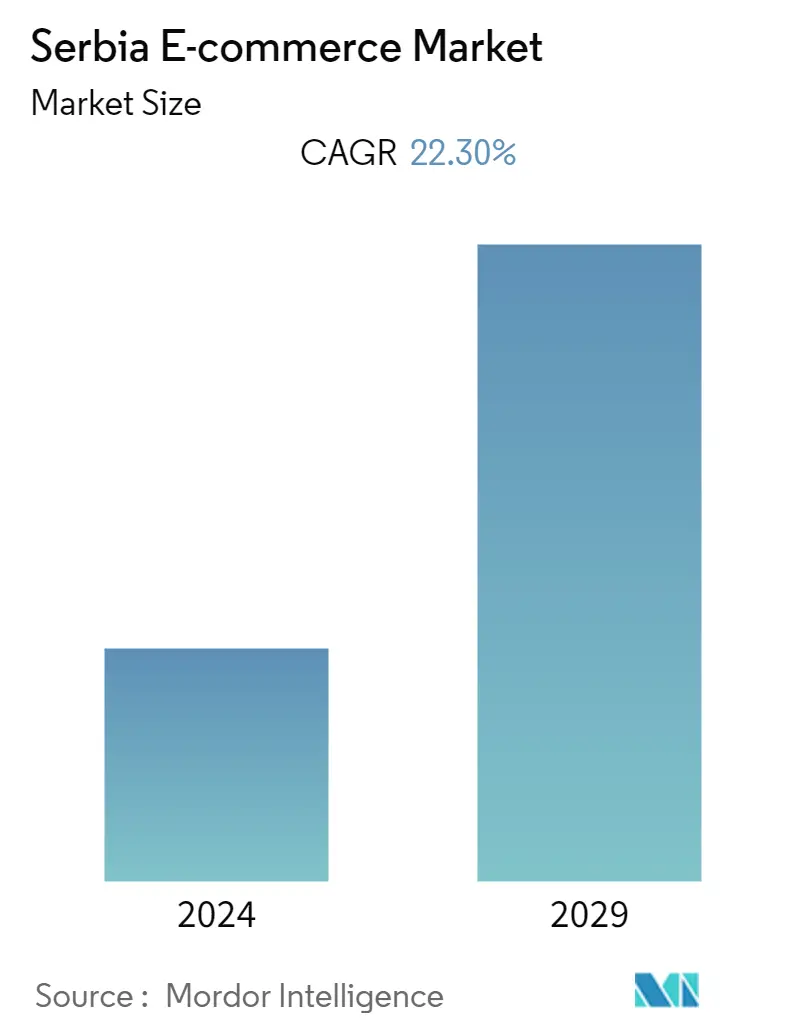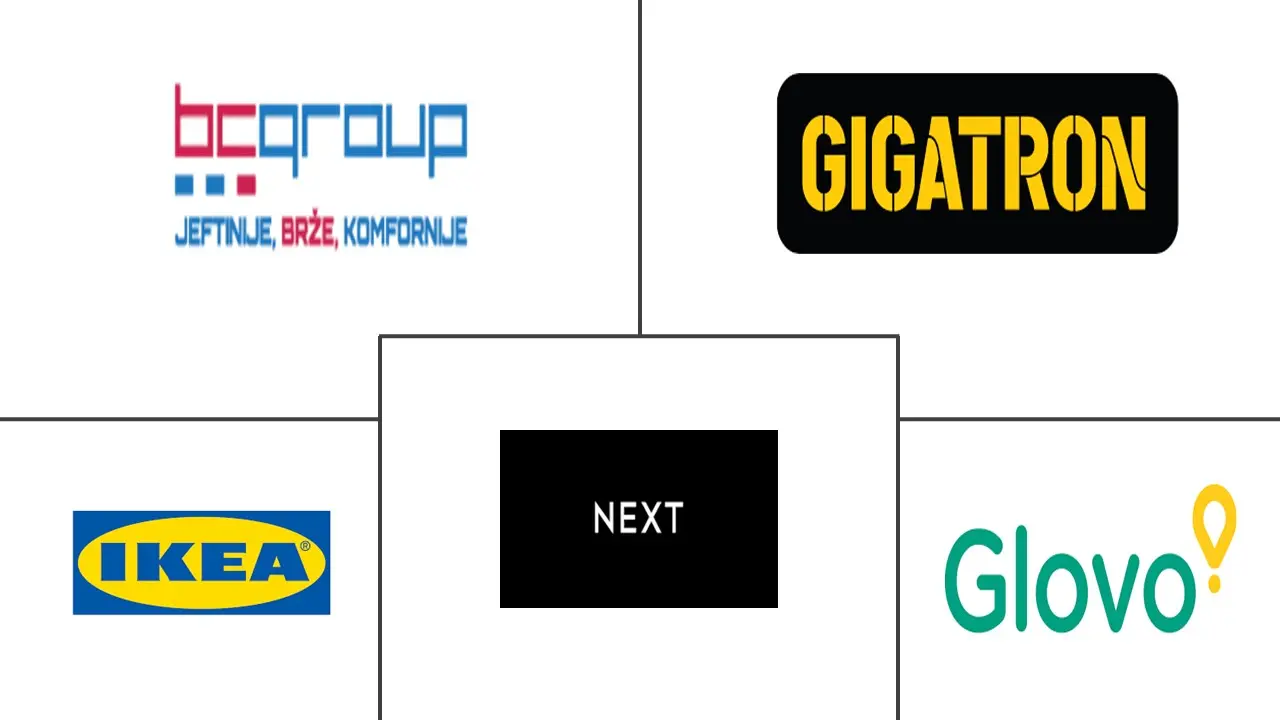Market Size of Serbia E-commerce Industry

| Study Period | 2019 - 2029 |
| Base Year For Estimation | 2023 |
| Forecast Data Period | 2024 - 2029 |
| Historical Data Period | 2019 - 2022 |
| CAGR | 22.30 % |
| Market Concentration | Medium |
Major Players
*Disclaimer: Major Players sorted in no particular order |
Serbia E-Commerce Market Analysis
E-commerce is becoming an increasingly popular form of purchasing goods and services among the citizens of Serbia. The number of internet users in the Republic of Serbia is undoubtedly increasing daily. The e-commerce market in Serbia is expected to register a CAGR of 22.3% during the forecast period (2022 - 2027).
The Internet is widespread in Serbia, but Serbia lags behind the developed countries of Western Europe. Serbia is one of the leading countries in the West Balkan region in terms of absolute and relative numbers of online shoppers. However, this is far behind Western European countries, where more than 80% of the population buys at least one product online.
The development of the digital economy, and therefore the growth of e-commerce, is one of the Government's priorities in the country. The Program for the Development of E-Commerce in the Republic of Serbia for the period 2020 was adopted, with an Action Plan having a set of measures and actions aimed at improving all elements in the field of e-commerce boosting customer assurance in online shopping, preserving the position of e-merchants, improving logistics flows, enabling electronic payment, etc.
Consumer spending has improved in 2020 and early 2021, and growth is expected to exceed the EU average by 2022. In 2020, the National Bank of Serbia recorded a significant increase in online purchases primarily attributed to the COVID-19 pandemic. However, household spending on non-food and services is expected to witness restrained growth beyond this period as consumers are unable to shift spending to less essential items due to the relatively low projected long-term GDP growth.
However, the Government has introduced new obligations for postal service providers to identify the sender and recipient of parcels. Implementing e-commerce is critical, and many government agencies still avoid public consultations and RIA. This can make long-term business planning a significant challenge, and access to adequate financial resources for Serbian consumers/importers could also be an issue.
According to the International Trade Administration, Serbian e-commerce doubled during the COVID-19 pandemic. Online grocery sales witnessed the most significant surge, followed by clothing and shoe sales and technology sales. According to the Serbian Statistics Bureau, Serbia had 3.3 million online customers in 2020.
Serbia E-Commerce Industry Segmentation
E-commerce, also known as e-commerce or internet commerce, refers to buying and selling goods or services over the internet and transferring money and data to complete those transactions. E-commerce is often used to refer to the sale of physical goods online, but it can also represent any kind of commerce facilitated by the internet. The market studied briefs about the ongoing trends and challenges of the E-commerce market in Serbia. Also, the market is segmented based on application type, and the studied market includes the major player's recent innovations made in the e-commerce market in the country.
| By B2C ecommerce | ||||||||
| Market size (GMV) for the period of 2017-2027 | ||||||||
|
| By B2B ecommerce | |
| Market size for the period of 2017-2027 |
Serbia E-commerce Market Size Summary
The e-commerce landscape in Serbia is experiencing significant growth, driven by an increasing number of internet users and a burgeoning digital economy. The Serbian government has prioritized the development of e-commerce, implementing programs and action plans to enhance online shopping experiences, improve logistics, and facilitate electronic payments. Despite being a leader in the West Balkan region, Serbia still trails behind Western European countries in terms of online shopping penetration. The COVID-19 pandemic acted as a catalyst, doubling the e-commerce market and boosting online grocery, clothing, and technology sales. However, challenges such as inadequate infrastructure, slower internet speeds, and limited financial support for startups persist, particularly outside major cities like Belgrade, Novi Sad, and Niš.
The Serbian e-commerce market is moderately fragmented, with large domestic companies and increasing competition from new entrants offering innovative online shopping solutions. The fashion industry has seen a notable shift towards online shopping, with significant investments in digital channels. Initiatives like the launch of shoppster.com and collaborations with the Ministry of Finance and national postal services aim to enhance cross-border e-commerce. The market is also witnessing strategic expansions by international brands and local companies, further fueling growth. Despite these advancements, the market faces challenges such as logistics issues and the need for better infrastructure to support the growing demand for online shopping.
Serbia E-commerce Market Size - Table of Contents
-
1. MARKET INSIGHTS
-
1.1 Market Overview
-
1.2 Industry Attractiveness-Porter's Five Forces Analysis
-
1.2.1 Bargaining Power of Suppliers
-
1.2.2 Bargaining Power of Buyers/Consumers
-
1.2.3 Threat of New Entrants
-
1.2.4 Threat of Substitute Products
-
1.2.5 Intensity of Competitive Rivalry
-
-
1.3 Key market trends and share of e-commerce of total Retail sector
-
1.4 Impact of COVID-19 on the e-commerce sales
-
-
2. Market Segmentation
-
2.1 By B2C ecommerce
-
2.1.1 Market size (GMV) for the period of 2017-2027
-
2.1.2 Market Segmentation - by Application
-
2.1.2.1 Beauty & Personal Care
-
2.1.2.2 Consumer Electronics
-
2.1.2.3 Fashion & Apparel
-
2.1.2.4 Food & Beverage
-
2.1.2.5 Furniture & Home
-
2.1.2.6 Others (Toys, DIY, Media, etc.)
-
-
-
2.2 By B2B ecommerce
-
2.2.1 Market size for the period of 2017-2027
-
-
Serbia E-commerce Market Size FAQs
What is the current Serbia E-commerce Market size?
The Serbia E-commerce Market is projected to register a CAGR of 22.30% during the forecast period (2024-2029)
Who are the key players in Serbia E-commerce Market?
Next Retail Ltd., Gigatron, Glovo, Ikea Systems BV and BC Group are the major companies operating in the Serbia E-commerce Market.

